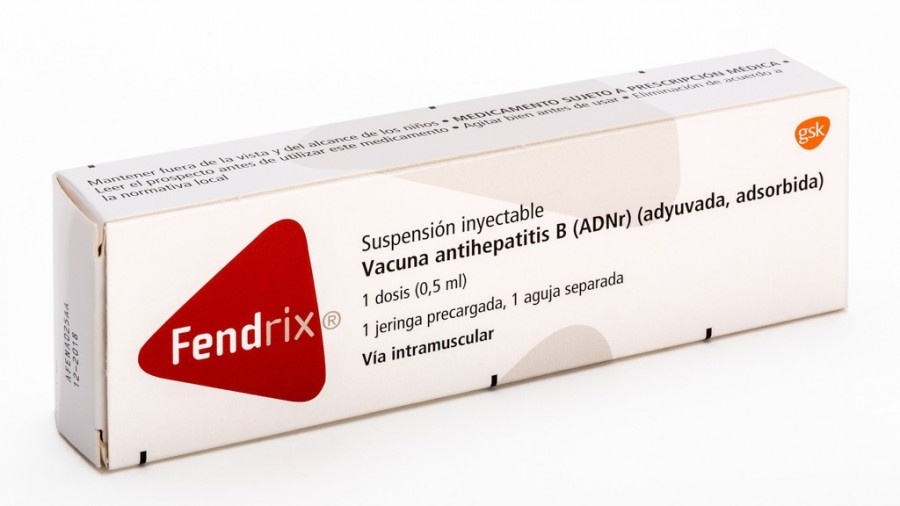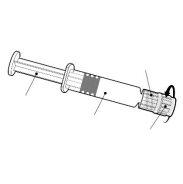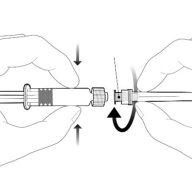

FENDRIX, INJECTABLE SUSPENSION


How to use FENDRIX, INJECTABLE SUSPENSION
Introduction
Package Leaflet: Information for the User
Fendrix Injectable Suspension
Hepatitis B vaccine (ADNr) (adjuvanted, adsorbed)
Read all of this leaflet carefully before you receive this vaccine because it contains important information for you.
- Keep this leaflet, you may need to read it again.
- If you have any further questions, ask your doctor or pharmacist.
- This vaccine has been prescribed for you, do not pass it on to others.
- If you experience any side effects, talk to your doctor or pharmacist, even if they are not listed in this leaflet. See section 4.
Contents of the pack
- What Fendrix is and what it is used for
- What you need to know before you receive Fendrix
- How Fendrix is administered
- Possible side effects
- Storage of Fendrix
- Contents of the pack and other information
1. What Fendrix is and what it is used for
Fendrix is a vaccine that prevents hepatitis B.
It is used in patients with kidney problems:
- patients undergoing haemodialysis, where a dialysis machine removes waste products from the blood
- patients who will be undergoing haemodialysis in the future.
Fendrix is for adults and adolescents from 15 years of age.
What is hepatitis B
Hepatitis B is caused by a virus that makes the liver swell.
- Signs may not appear until 6 weeks to 6 months after infection.
- The main signs of the disease include mild flu-like symptoms, such as headache or fever, extreme tiredness, dark urine, pale stools, yellow eyes or skin (jaundice). These or other signs may mean that the person needs hospital treatment. Most people recover completely from the disease.
- Some people with hepatitis B may not appear to be ill or may not feel ill (they have no signs of the disease).
- The virus is found in body fluids such as vaginal fluid, blood, semen or saliva (sputum).
Hepatitis B carriers
- The hepatitis B virus remains in some people's bodies for their entire lives.
- This means they can infect others and are known as carriers of the virus.
- Carriers of the virus are likely to develop serious liver problems, such as cirrhosis or liver cancer.
How Fendrix works
- Fendrix helps your body develop its own protection against the virus (antibodies). These antibodies will protect you against the disease.
- Fendrix contains two substances called MPL (a purified non-toxic bacterial derivative) and aluminium phosphate. Both allow the vaccine to work faster, better and for longer.
- As with all vaccines, a course of vaccination with Fendrix may not completely protect all vaccinated individuals.
- Fendrix may not protect you against the disease if you have already been infected with the hepatitis B virus.
- Fendrix can only protect you against infection with the hepatitis B virus. It cannot protect you against other infections that may affect the liver, even if these infections have similar signs to those caused by the hepatitis B virus.
2. What you need to know before you receive Fendrix
Fendrix must not be administered
- if you are allergic to the active substance or to any of the other ingredients of this medicine (listed in section 6). Signs of an allergic reaction may include: skin rash with itching, difficulty breathing and swelling of the face or tongue
- if you have ever had an allergic reaction to any hepatitis B vaccine
- if you have a severe infection with fever. The vaccine can be given once you have recovered. A minor infection, such as a cold, should not be a problem for vaccination, but tell your doctor first.
Fendrix must not be administered if any of the above applies to you. If you are not sure, consult your doctor or pharmacist before receiving Fendrix.
Warnings and precautions
Consult your doctor or pharmacist before Fendrix is administered to you:
- if you have known allergies
- if you have had any health problems after receiving a vaccine in the past.
Fainting (especially in adolescents) may occur before or after any injection, so you should tell your doctor or nurse if you have fainted after a previous injection.
If any of the above applies to you (or if you are not sure), consult your doctor or pharmacist before receiving Fendrix.
Other medicines and Fendrix
Tell your doctor if you are using, have recently used or might use any other medicines or if you have recently received any other vaccine.
- You should have a gap of at least 2 to 3 weeks between administration of Fendrix and any other vaccine.
- Fendrix may need to be administered at the same time as a hepatitis B immunoglobulin injection. Your doctor will make sure that the vaccines are administered in different parts of the body.
Pregnancy, breastfeeding and fertility
If you are pregnant or breastfeeding, think you may be pregnant or are planning to have a baby, ask your doctor for advice before receiving this vaccine.
Driving and using machines
You may feel tired or have a headache after receiving Fendrix. If this happens, be extra careful while driving or using tools or machines.
Fendrix contains sodium
This vaccine contains less than 1 mmol of sodium (23 mg) per dose, i.e. it is essentially “sodium-free”.
3. How Fendrix is administered
How the vaccine is administered
Your doctor or nurse will inject Fendrix into a muscle, usually in the upper part of your arm.
How much is administered
- You will receive a series of four injections.
- The injections will be given over a period of 6 months:
- First injection: on the date agreed with your doctor.
- Second injection: 1 month after the first injection
- Third injection: 2 months after the first injection.
- Fourth injection: 6 months after the first injection.
- Your doctor or nurse will tell you when to come back for the next injections.
- Once you have received the first injection of Fendrix, it is necessary that the next injections are also of Fendrix (not another type of hepatitis B vaccine).
Your doctor will tell you if you need any additional injections or booster doses in the future. Fendrix can also be used as a booster dose after a course of vaccination with a different type of hepatitis B vaccine.
If you miss a dose
- If you miss an injection, contact your doctor and make another appointment.
- Make sure you complete the full course of four injections. Otherwise, you may not be fully protected against the disease.
4. Possible side effects
Like all medicines, this vaccine can cause side effects, although not everybody gets them.
The following side effects may occur with this vaccine. Their frequency is defined as follows:
Very common(these may occur with more than 1 in 10 doses of the vaccine): headache, feeling tired, pain or discomfort where the injection was given.
Common(these may occur with up to 1 in 10 doses of the vaccine): redness or swelling where the injection was given, fever, digestion and stomach problems.
Uncommon(these may occur with up to 1 in 100 doses of the vaccine): chills, skin rash with redness, other reactions where the injection was given.
Rare(these may occur with up to 1 in 1,000 doses of the vaccine): allergic reactions, flushing, feeling dizzy, feeling thirsty, feeling nervous, viral infection, back pain, tendon inflammation.
The following side effects have also been reported with other hepatitis B vaccines:
Very rare(these may occur with up to 1 in 10,000 doses of the vaccine): seizures, fainting, problems with the nerves of your eye (optic neuritis), multiple sclerosis, loss of sensation or problems moving some parts of your body, severe headache with stiff neck, numbness or weakness of arms and legs (neuropathy), nerve inflammation (neuritis), weakness and paralysis of the limbs progressing to the chest and face (Guillain-Barré syndrome), brain swelling or infection (encephalitis, encephalopathy).
Allergic reactions, including anaphylactoid reactions, may also occur very rarely (up to 1 in 10,000 doses of the vaccine). These can be local or widespread skin rashes with itching or blisters, swelling of the eyes and face, difficulty breathing or swallowing, sudden drop in blood pressure and loss of consciousness. These reactions can occur before you leave the doctor's surgery. However, seek medical attention immediately in any case.
Reporting of side effects
If you experience any side effects, talk to your doctor or pharmacist, even if they are not listed in this leaflet. You can also report side effects directly via the Spanish Medicines Agency's website for reporting adverse reactions, https://www.notificaram.es. By reporting side effects, you can help provide more information on the safety of this medicine.
5. Storage of Fendrix
- Keep this vaccine out of the sight and reach of children.
- Do not use this vaccine after the expiry date stated on the pack. The expiry date is the last day of the month stated.
- Store in a refrigerator (between 2 °C and 8 °C).
- Store in the original package to protect from light.
- Do not freeze. Freezing destroys the vaccine.
- Medicines should not be disposed of via wastewater or household waste. Ask your pharmacist how to dispose of medicines no longer required. This will help protect the environment.
6. Container contents and additional information
Fendrix composition
- The active ingredient in 1 dose (0.5 ml) of Fendrix is:
Hepatitis B virus surface antigen 1, 2, 3 20 micrograms
Adjuvanted by AS04C which contains:
3-O-desacil-4'-monophosphoryl lipid A (MPL) 50 micrograms
Adsorbed on aluminum phosphate (0.5 milligrams of Al3+ in total)
Produced by recombinant DNA technology in yeast cells (Saccharomyces cerevisiae)
- The other components of Fendrix are: sodium chloride, water for injectable preparations.
Product appearance and container contents
Fendrix is a white and milky suspension.
Fendrix is available in a pre-filled syringe with or without separate needles, package sizes of 1 and 10.
Only some package sizes may be marketed.
Marketing authorization holder and manufacturer:
GlaxoSmithKline Biologicals s.a.
Rue de l’Institut 89
B-1330 Rixensart
Belgium
For further information on this medicinal product, please contact the local representative of the marketing authorization holder:
België/Belgique/Belgien GlaxoSmithKline Pharmaceuticals SA/NV Tel: + 32 10 85 52 00 | Lietuva GlaxoSmithKline Biologicals SA Tel: +370 80000334 |
България GlaxoSmithKline Biologicals SA Tel: + 359 80018205 | Luxembourg/Luxemburg GlaxoSmithKline Pharmaceuticals SA/NV Tel: + 32 10 85 52 00 |
Ceská republika GlaxoSmithKline s.r.o. Tel: + 420 2 22 00 11 11 cz.info@gsk.com | Magyarország GlaxoSmithKline Biologicals SA Tel: + 36 80088309 |
Danmark GlaxoSmithKline Pharma A/S Tlf: + 45 36 35 91 00 dk-info@gsk.com | Malta GlaxoSmithKline Biologicals SA Tel: + 356 80065004 |
Deutschland GlaxoSmithKline GmbH & Co. KG Tel: + 49 (0)89 360448701 produkt.info@gsk.com | Nederland GlaxoSmithKline BV Tel: + 31 (0)30 69 38 100 |
Eesti GlaxoSmithKline Biologicals SA Tel: +372 8002640 | Norge GlaxoSmithKline AS Tlf: + 47 22 70 20 00 |
Ελλάδα GlaxoSmithKline Μονοπρόσωπη A.E.B.E. Τηλ: + 30 210 68 82 100 | Österreich GlaxoSmithKline Pharma GmbH. Tel: + 43 (0)1 970 75-0 at.info@gsk.com |
España GlaxoSmithKline, S.A. Tel: + 34 900 202 700 es-ci@gsk.com | Polska GSK Services Sp. z o.o. Tel: + 48 (22) 576 9000 |
France Laboratoire GlaxoSmithKline Tél: + 33 (0) 1 39 17 84 44 diam@gsk.com Hrvatska GlaxoSmithKline Biologicals SA Tel: + 385 800787089 | Portugal Smith Kline & French Portuguesa - Produtos Farmacêuticos, Lda. Tel: + 351 21 412 95 00 FI.PT@gsk.com România GlaxoSmithKline Biologicals SA Tel: +40 800672524 |
Ireland GlaxoSmithKline (Ireland) Ltd Tel: + 353 (0)1 495 5000 | Slovenija GlaxoSmithKline Biologicals SA Tel: + 386 80688869 |
Ísland Vistor hf. Sími: +354 535 7000 | Slovenská republika GlaxoSmithKline Biologicals SA Tel: + 421 800500589 |
Italia GlaxoSmithKline S.p.A. Tel: + 39 (0)45 774 1111 | Suomi/Finland GlaxoSmithKline Oy Puh/Tel: + 358 10 30 30 30 |
Κύπρος GlaxoSmithKline Biologicals SA Τηλ: + 357 80070017 | Sverige GlaxoSmithKline AB Tel: + 46 (0)8 638 93 00 info.produkt@gsk.com |
Latvija GlaxoSmithKline Biologicals SA Tel: + 371 80205045 | United Kingdom (Northern Ireland) GlaxoSmithKline Biologicals SA Tel: +44 (0)800 221 441 customercontactuk@gsk.com |
Date of last revision of this leaflet:04/2023
Other sources of information
Detailed information on this medicinal product is available on the European Medicines Agency website: http://www.ema.europa.eu, and on the website of the Spanish Agency for Medicines and Health Products (AEMPS) (http://www.aemps.gob.es/).
-------------------------------------------------------------------------------------------------------------------------
This information is intended only for healthcare professionals:
During storage of the vaccine, a fine white deposit and a clear supernatant may be observed.
Before administration, the vaccine should be shaken well to obtain a slightly opaque white suspension.
The vaccine should be inspected visually before and after resuspension for any foreign particles and/or changes in physical appearance. The vaccine should not be used if there has been a change in the appearance of the vaccine.
Disposal of unused medicinal products and all materials that have come into contact with them should be done in accordance with local regulations.
Fendrix should not be administered to subjects with hypersensitivity to the active substance or to any of the excipients.
Fendrix should not be administered to subjects with hypersensitivity after a previous administration of other hepatitis B vaccines.
Fendrix should not be administered to subjects with acute severe febrile illnesses. The presence of a minor infection, such as a cold, is not a contraindication for vaccination.
Fendrix should be injected intramuscularly in the deltoid region.
Intramuscular administration in the gluteal muscle should be avoided as it may lead to a suboptimal immune response to the vaccine.
Fendrix should not be administered intradermally or intravenously under any circumstances.
Due to the fact that pre-dialysis and dialysis patients are particularly exposed to HBV and have a higher risk of being chronically infected, a preventive attitude should be considered, i.e., a booster dose should be administered to ensure a protective level of antibodies based on local recommendations and guidelines.
Adequate medical treatment should be available at all times in the event of an anaphylactic reaction following administration of the vaccine.
Instructions for the pre-filled syringe
| Hold the syringe by the body, not by the plunger. Unscrew the syringe cap by turning it counterclockwise. |
| To insert the needle, connect the base to the Luer-Lock adapter and turn it a quarter turn clockwise until it clicks. Do not pull the plunger out of the syringe body. If this happens, do not administer the vaccine. |
Waste disposal
Disposal of unused medicinal products and all materials that have come into contact with them should be done in accordance with local regulations.
- Country of registration
- Active substance
- Prescription requiredYes
- Manufacturer
- CompositionCLORURO DE SODIO (0 - mg)
- This information is for reference only and does not constitute medical advice. Always consult a licensed doctor before taking any medication. Oladoctor is not responsible for medical decisions based on this content.
- Alternatives to FENDRIX, INJECTABLE SUSPENSIONDosage form: INJECTABLE, 20 mcg Hepatitis B Surface Antigen/ mlActive substance: hepatitis B, purified antigenManufacturer: Glaxosmithkline S.A.Prescription requiredDosage form: INJECTABLE, 10 mcg Hepatitis B Surface Antigen / 0.5 mlActive substance: hepatitis B, purified antigenManufacturer: Glaxosmithkline S.A.Prescription requiredDosage form: INJECTABLE, 20 µgActive substance: hepatitis B, purified antigenManufacturer: Glaxosmithkline BiologicalsPrescription required











